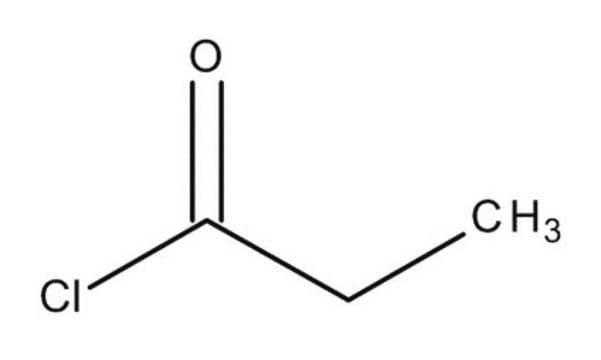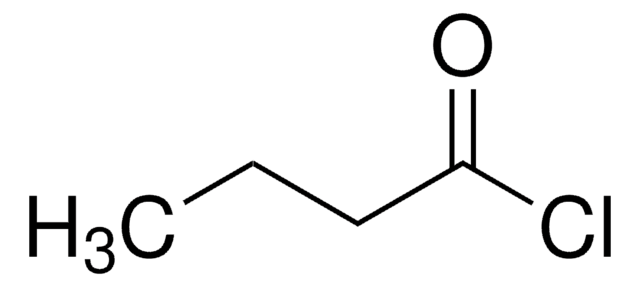P51559
Propionyl chloride
98%
Synonym(s):
Chloro ethyl ketone, Ethyl chloroform, Propionic acid chloride, Prorionyl chloride
About This Item
Recommended Products
vapor density
3.2 (vs air)
Assay
98%
refractive index
n20/D 1.404 (lit.)
bp
77-79 °C (lit.)
mp
−94 °C
density
1.059 g/mL at 25 °C (lit.)
SMILES string
CCC(Cl)=O
InChI
1S/C3H5ClO/c1-2-3(4)5/h2H2,1H3
InChI key
RZWZRACFZGVKFM-UHFFFAOYSA-N
Looking for similar products? Visit Product Comparison Guide
General description
Application
- To convert anisole to 4-methoxypropiophenone and 2-methoxynaphthalene to 1-propio-2-methoxynaphthalene in the presence of Indium(III) chloride (InCl3) impregnated mesoporous Si-MCM-41 catalyst.
It can also be used:
- For chlorination in the presence of sulfuryl chloride and peroxides to form α-chloropropionyl chloride and β-chloropropionyl chloride.
- In reaction with (hydroxypropyl)cellulose to form the propanoate ester, [(propionyloxy)propyl]cellulose.
Signal Word
Danger
Hazard Statements
Precautionary Statements
Hazard Classifications
Acute Tox. 3 Inhalation - Acute Tox. 4 Oral - Eye Dam. 1 - Flam. Liq. 2 - Skin Corr. 1B
Supplementary Hazards
Storage Class Code
3 - Flammable liquids
WGK
WGK 1
Flash Point(F)
42.8 °F - closed cup
Flash Point(C)
6 °C - closed cup
Personal Protective Equipment
Certificates of Analysis (COA)
Search for Certificates of Analysis (COA) by entering the products Lot/Batch Number. Lot and Batch Numbers can be found on a product’s label following the words ‘Lot’ or ‘Batch’.
Already Own This Product?
Find documentation for the products that you have recently purchased in the Document Library.
Customers Also Viewed
Our team of scientists has experience in all areas of research including Life Science, Material Science, Chemical Synthesis, Chromatography, Analytical and many others.
Contact Technical Service
















